In-depth Book Review: Clearing the Plains - Indigenous Studies 100
VerifiedAdded on 2023/04/24
|5
|1265
|237
Essay
AI Summary
This essay provides a comprehensive book review of James Daschuk's 'Clearing the Plains,' focusing on the disparities between Indigenous and non-native peoples in Canada. It discusses Daschuk's arguments regarding political, economic, and ecological systems that led to these disparities, supported by historical evidence. The review highlights the book's strengths in exposing the dark side of Canadian governmental policies and its analysis of the health outcomes of the First Nations. It also points out limitations, such as the lack of comparison between Indigenous and non-native living conditions during the 18th and 19th centuries. The review concludes by acknowledging the book's contribution to informing politicians and policymakers and its role in promoting a deeper understanding of inequalities in Canada. Desklib provides access to similar essays and study resources for students.
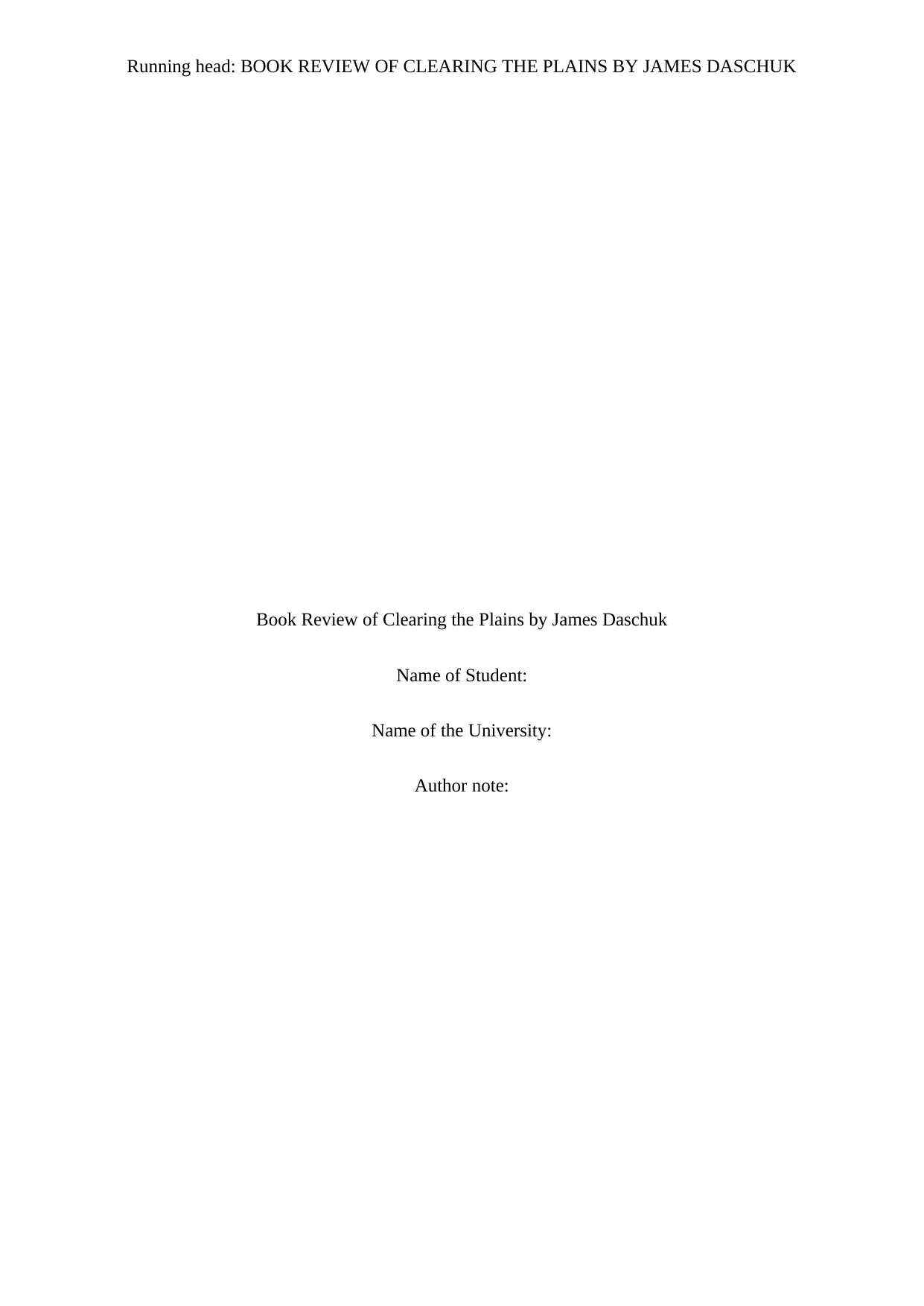
Running head: BOOK REVIEW OF CLEARING THE PLAINS BY JAMES DASCHUK
Book Review of Clearing the Plains by James Daschuk
Name of Student:
Name of the University:
Author note:
Book Review of Clearing the Plains by James Daschuk
Name of Student:
Name of the University:
Author note:
Paraphrase This Document
Need a fresh take? Get an instant paraphrase of this document with our AI Paraphraser
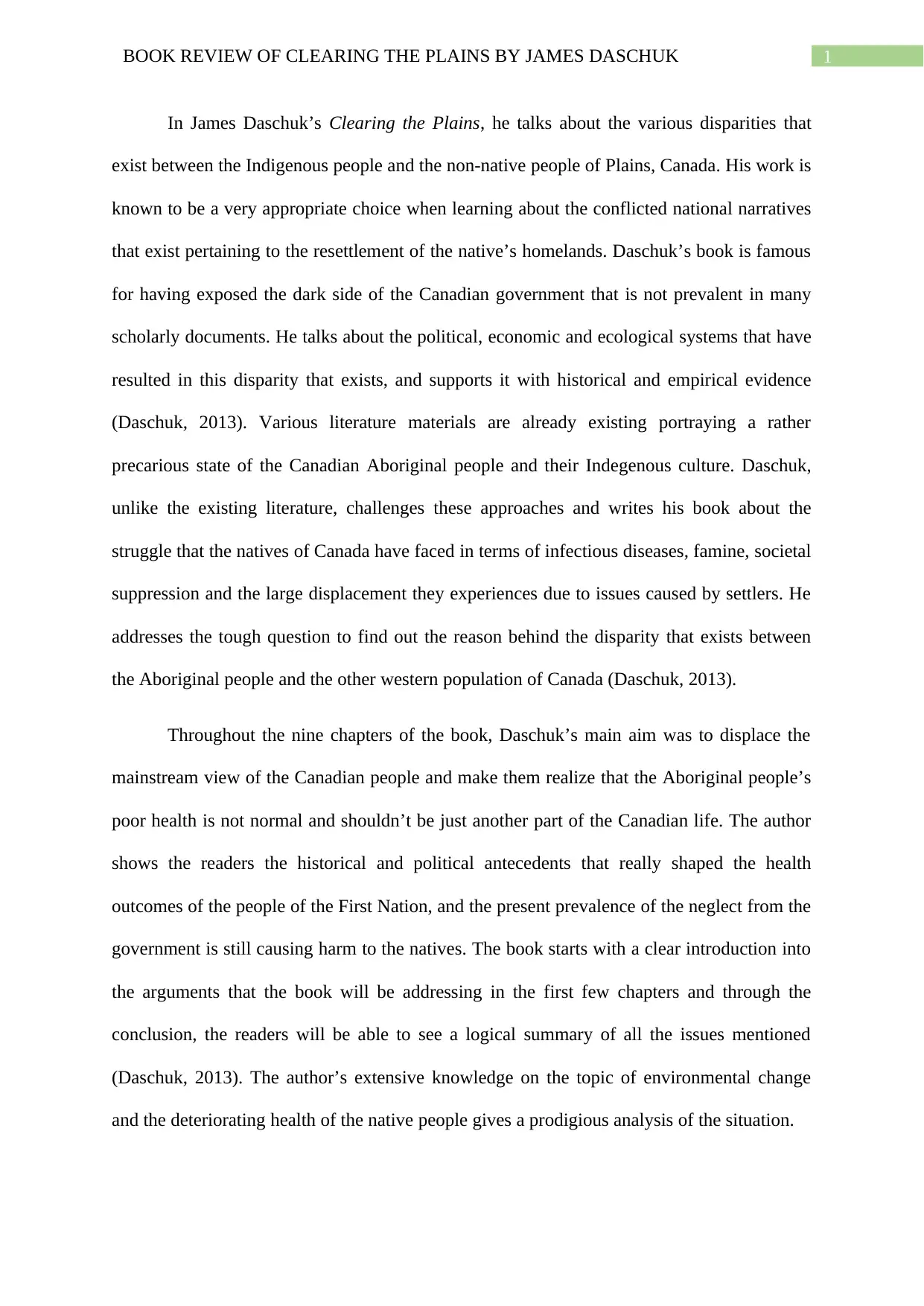
1BOOK REVIEW OF CLEARING THE PLAINS BY JAMES DASCHUK
In James Daschuk’s Clearing the Plains, he talks about the various disparities that
exist between the Indigenous people and the non-native people of Plains, Canada. His work is
known to be a very appropriate choice when learning about the conflicted national narratives
that exist pertaining to the resettlement of the native’s homelands. Daschuk’s book is famous
for having exposed the dark side of the Canadian government that is not prevalent in many
scholarly documents. He talks about the political, economic and ecological systems that have
resulted in this disparity that exists, and supports it with historical and empirical evidence
(Daschuk, 2013). Various literature materials are already existing portraying a rather
precarious state of the Canadian Aboriginal people and their Indegenous culture. Daschuk,
unlike the existing literature, challenges these approaches and writes his book about the
struggle that the natives of Canada have faced in terms of infectious diseases, famine, societal
suppression and the large displacement they experiences due to issues caused by settlers. He
addresses the tough question to find out the reason behind the disparity that exists between
the Aboriginal people and the other western population of Canada (Daschuk, 2013).
Throughout the nine chapters of the book, Daschuk’s main aim was to displace the
mainstream view of the Canadian people and make them realize that the Aboriginal people’s
poor health is not normal and shouldn’t be just another part of the Canadian life. The author
shows the readers the historical and political antecedents that really shaped the health
outcomes of the people of the First Nation, and the present prevalence of the neglect from the
government is still causing harm to the natives. The book starts with a clear introduction into
the arguments that the book will be addressing in the first few chapters and through the
conclusion, the readers will be able to see a logical summary of all the issues mentioned
(Daschuk, 2013). The author’s extensive knowledge on the topic of environmental change
and the deteriorating health of the native people gives a prodigious analysis of the situation.
In James Daschuk’s Clearing the Plains, he talks about the various disparities that
exist between the Indigenous people and the non-native people of Plains, Canada. His work is
known to be a very appropriate choice when learning about the conflicted national narratives
that exist pertaining to the resettlement of the native’s homelands. Daschuk’s book is famous
for having exposed the dark side of the Canadian government that is not prevalent in many
scholarly documents. He talks about the political, economic and ecological systems that have
resulted in this disparity that exists, and supports it with historical and empirical evidence
(Daschuk, 2013). Various literature materials are already existing portraying a rather
precarious state of the Canadian Aboriginal people and their Indegenous culture. Daschuk,
unlike the existing literature, challenges these approaches and writes his book about the
struggle that the natives of Canada have faced in terms of infectious diseases, famine, societal
suppression and the large displacement they experiences due to issues caused by settlers. He
addresses the tough question to find out the reason behind the disparity that exists between
the Aboriginal people and the other western population of Canada (Daschuk, 2013).
Throughout the nine chapters of the book, Daschuk’s main aim was to displace the
mainstream view of the Canadian people and make them realize that the Aboriginal people’s
poor health is not normal and shouldn’t be just another part of the Canadian life. The author
shows the readers the historical and political antecedents that really shaped the health
outcomes of the people of the First Nation, and the present prevalence of the neglect from the
government is still causing harm to the natives. The book starts with a clear introduction into
the arguments that the book will be addressing in the first few chapters and through the
conclusion, the readers will be able to see a logical summary of all the issues mentioned
(Daschuk, 2013). The author’s extensive knowledge on the topic of environmental change
and the deteriorating health of the native people gives a prodigious analysis of the situation.
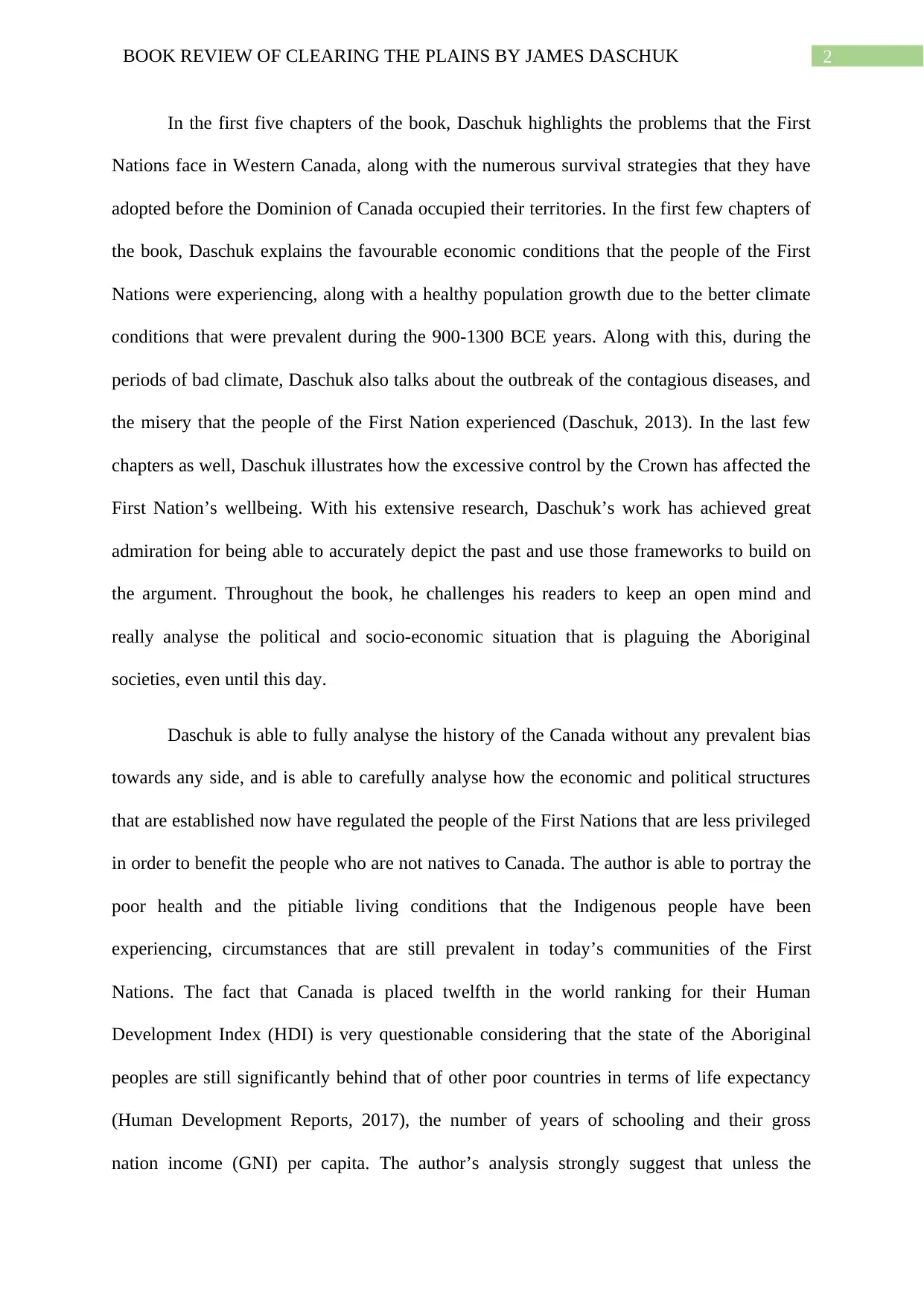
2BOOK REVIEW OF CLEARING THE PLAINS BY JAMES DASCHUK
In the first five chapters of the book, Daschuk highlights the problems that the First
Nations face in Western Canada, along with the numerous survival strategies that they have
adopted before the Dominion of Canada occupied their territories. In the first few chapters of
the book, Daschuk explains the favourable economic conditions that the people of the First
Nations were experiencing, along with a healthy population growth due to the better climate
conditions that were prevalent during the 900-1300 BCE years. Along with this, during the
periods of bad climate, Daschuk also talks about the outbreak of the contagious diseases, and
the misery that the people of the First Nation experienced (Daschuk, 2013). In the last few
chapters as well, Daschuk illustrates how the excessive control by the Crown has affected the
First Nation’s wellbeing. With his extensive research, Daschuk’s work has achieved great
admiration for being able to accurately depict the past and use those frameworks to build on
the argument. Throughout the book, he challenges his readers to keep an open mind and
really analyse the political and socio-economic situation that is plaguing the Aboriginal
societies, even until this day.
Daschuk is able to fully analyse the history of the Canada without any prevalent bias
towards any side, and is able to carefully analyse how the economic and political structures
that are established now have regulated the people of the First Nations that are less privileged
in order to benefit the people who are not natives to Canada. The author is able to portray the
poor health and the pitiable living conditions that the Indigenous people have been
experiencing, circumstances that are still prevalent in today’s communities of the First
Nations. The fact that Canada is placed twelfth in the world ranking for their Human
Development Index (HDI) is very questionable considering that the state of the Aboriginal
peoples are still significantly behind that of other poor countries in terms of life expectancy
(Human Development Reports, 2017), the number of years of schooling and their gross
nation income (GNI) per capita. The author’s analysis strongly suggest that unless the
In the first five chapters of the book, Daschuk highlights the problems that the First
Nations face in Western Canada, along with the numerous survival strategies that they have
adopted before the Dominion of Canada occupied their territories. In the first few chapters of
the book, Daschuk explains the favourable economic conditions that the people of the First
Nations were experiencing, along with a healthy population growth due to the better climate
conditions that were prevalent during the 900-1300 BCE years. Along with this, during the
periods of bad climate, Daschuk also talks about the outbreak of the contagious diseases, and
the misery that the people of the First Nation experienced (Daschuk, 2013). In the last few
chapters as well, Daschuk illustrates how the excessive control by the Crown has affected the
First Nation’s wellbeing. With his extensive research, Daschuk’s work has achieved great
admiration for being able to accurately depict the past and use those frameworks to build on
the argument. Throughout the book, he challenges his readers to keep an open mind and
really analyse the political and socio-economic situation that is plaguing the Aboriginal
societies, even until this day.
Daschuk is able to fully analyse the history of the Canada without any prevalent bias
towards any side, and is able to carefully analyse how the economic and political structures
that are established now have regulated the people of the First Nations that are less privileged
in order to benefit the people who are not natives to Canada. The author is able to portray the
poor health and the pitiable living conditions that the Indigenous people have been
experiencing, circumstances that are still prevalent in today’s communities of the First
Nations. The fact that Canada is placed twelfth in the world ranking for their Human
Development Index (HDI) is very questionable considering that the state of the Aboriginal
peoples are still significantly behind that of other poor countries in terms of life expectancy
(Human Development Reports, 2017), the number of years of schooling and their gross
nation income (GNI) per capita. The author’s analysis strongly suggest that unless the
⊘ This is a preview!⊘
Do you want full access?
Subscribe today to unlock all pages.

Trusted by 1+ million students worldwide
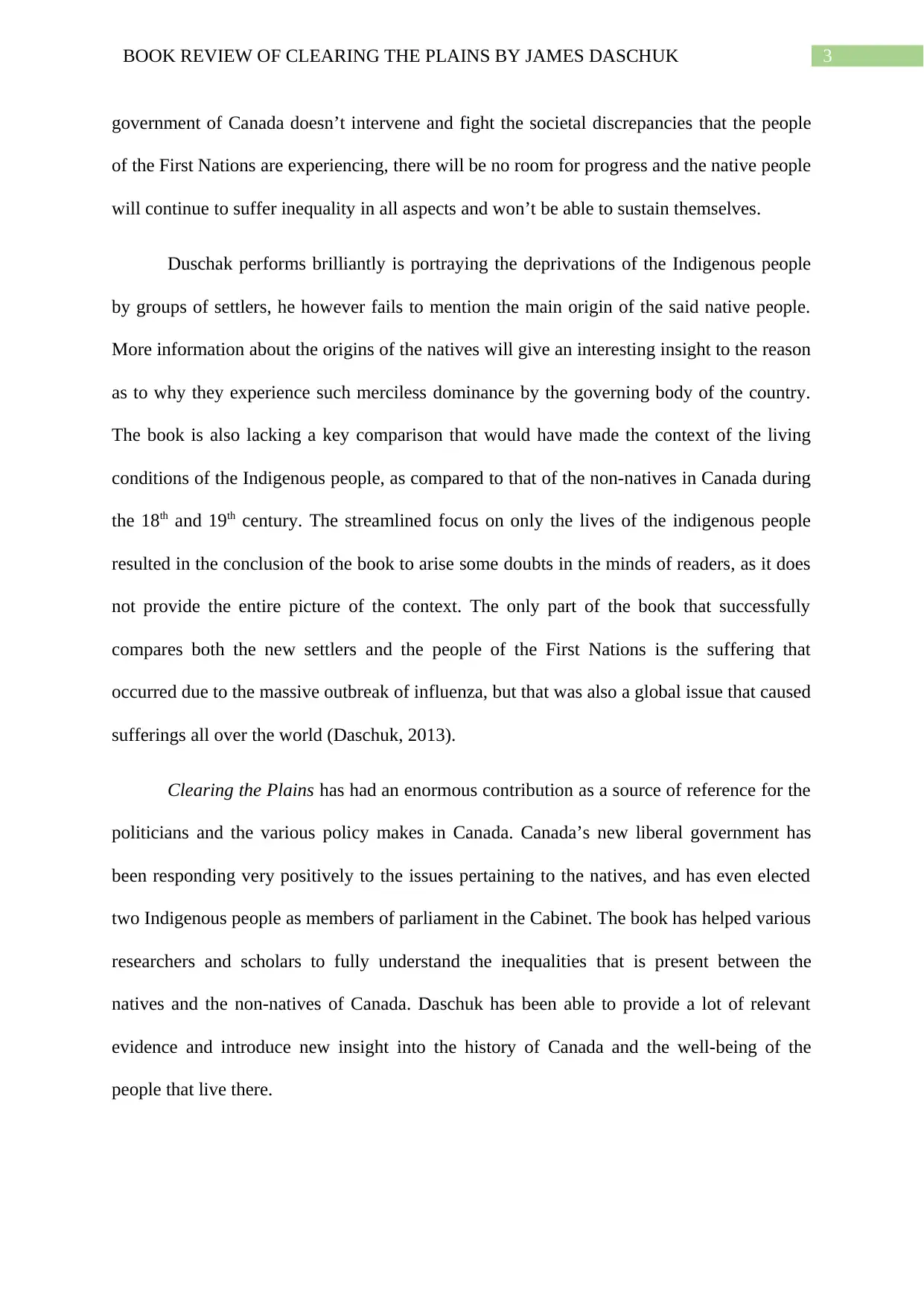
3BOOK REVIEW OF CLEARING THE PLAINS BY JAMES DASCHUK
government of Canada doesn’t intervene and fight the societal discrepancies that the people
of the First Nations are experiencing, there will be no room for progress and the native people
will continue to suffer inequality in all aspects and won’t be able to sustain themselves.
Duschak performs brilliantly is portraying the deprivations of the Indigenous people
by groups of settlers, he however fails to mention the main origin of the said native people.
More information about the origins of the natives will give an interesting insight to the reason
as to why they experience such merciless dominance by the governing body of the country.
The book is also lacking a key comparison that would have made the context of the living
conditions of the Indigenous people, as compared to that of the non-natives in Canada during
the 18th and 19th century. The streamlined focus on only the lives of the indigenous people
resulted in the conclusion of the book to arise some doubts in the minds of readers, as it does
not provide the entire picture of the context. The only part of the book that successfully
compares both the new settlers and the people of the First Nations is the suffering that
occurred due to the massive outbreak of influenza, but that was also a global issue that caused
sufferings all over the world (Daschuk, 2013).
Clearing the Plains has had an enormous contribution as a source of reference for the
politicians and the various policy makes in Canada. Canada’s new liberal government has
been responding very positively to the issues pertaining to the natives, and has even elected
two Indigenous people as members of parliament in the Cabinet. The book has helped various
researchers and scholars to fully understand the inequalities that is present between the
natives and the non-natives of Canada. Daschuk has been able to provide a lot of relevant
evidence and introduce new insight into the history of Canada and the well-being of the
people that live there.
government of Canada doesn’t intervene and fight the societal discrepancies that the people
of the First Nations are experiencing, there will be no room for progress and the native people
will continue to suffer inequality in all aspects and won’t be able to sustain themselves.
Duschak performs brilliantly is portraying the deprivations of the Indigenous people
by groups of settlers, he however fails to mention the main origin of the said native people.
More information about the origins of the natives will give an interesting insight to the reason
as to why they experience such merciless dominance by the governing body of the country.
The book is also lacking a key comparison that would have made the context of the living
conditions of the Indigenous people, as compared to that of the non-natives in Canada during
the 18th and 19th century. The streamlined focus on only the lives of the indigenous people
resulted in the conclusion of the book to arise some doubts in the minds of readers, as it does
not provide the entire picture of the context. The only part of the book that successfully
compares both the new settlers and the people of the First Nations is the suffering that
occurred due to the massive outbreak of influenza, but that was also a global issue that caused
sufferings all over the world (Daschuk, 2013).
Clearing the Plains has had an enormous contribution as a source of reference for the
politicians and the various policy makes in Canada. Canada’s new liberal government has
been responding very positively to the issues pertaining to the natives, and has even elected
two Indigenous people as members of parliament in the Cabinet. The book has helped various
researchers and scholars to fully understand the inequalities that is present between the
natives and the non-natives of Canada. Daschuk has been able to provide a lot of relevant
evidence and introduce new insight into the history of Canada and the well-being of the
people that live there.
Paraphrase This Document
Need a fresh take? Get an instant paraphrase of this document with our AI Paraphraser
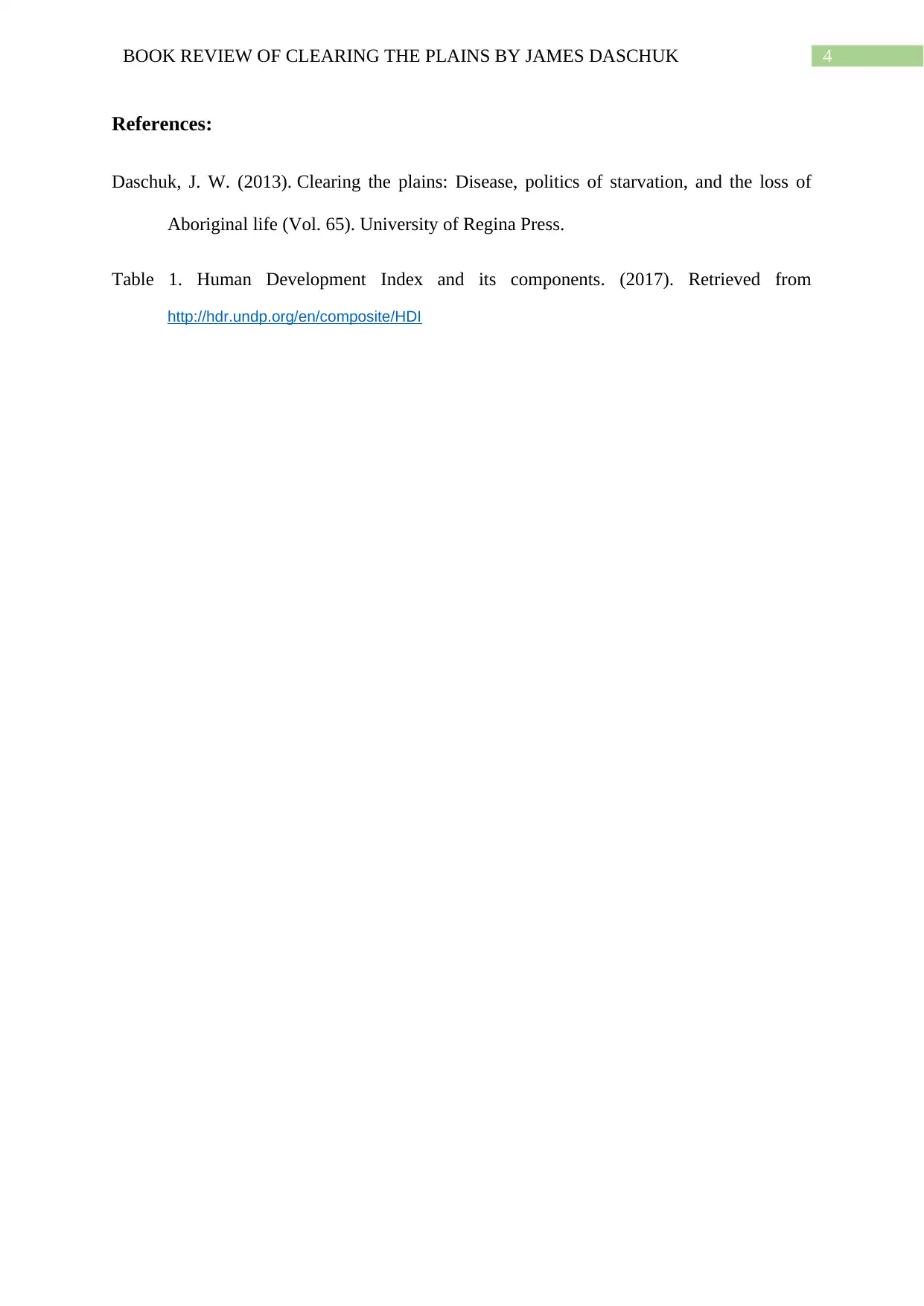
4BOOK REVIEW OF CLEARING THE PLAINS BY JAMES DASCHUK
References:
Daschuk, J. W. (2013). Clearing the plains: Disease, politics of starvation, and the loss of
Aboriginal life (Vol. 65). University of Regina Press.
Table 1. Human Development Index and its components. (2017). Retrieved from
http://hdr.undp.org/en/composite/HDI
References:
Daschuk, J. W. (2013). Clearing the plains: Disease, politics of starvation, and the loss of
Aboriginal life (Vol. 65). University of Regina Press.
Table 1. Human Development Index and its components. (2017). Retrieved from
http://hdr.undp.org/en/composite/HDI
1 out of 5
Related Documents
Your All-in-One AI-Powered Toolkit for Academic Success.
+13062052269
info@desklib.com
Available 24*7 on WhatsApp / Email
![[object Object]](/_next/static/media/star-bottom.7253800d.svg)
Unlock your academic potential
Copyright © 2020–2025 A2Z Services. All Rights Reserved. Developed and managed by ZUCOL.



